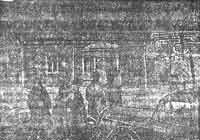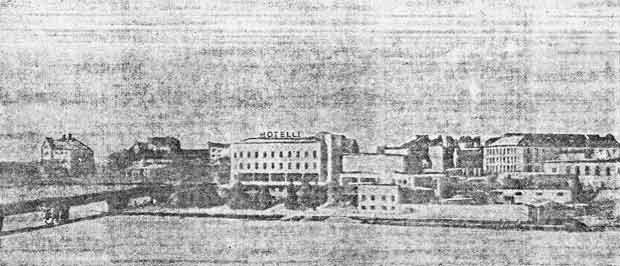In the new districts |
||||||||||||||
|
Our M-1 car for the whole day was heading towards the shores of the Ladoga Lake. From Petrozavodsk to Pryazha, Olonets, Pogrankondushi. The near-road villages are unusually liven up in these days. The truck convoys are running through. The wind-bitten faces of the soldiers are smiling. Here and there one can hear the songs and bursts of laugh. "Good-bye", cries the soldier from the Ukraine to Karelian girls. There are many familiar faces among soldiers and officers. Not too long ago they were workers and clerk in Petrozavodsk. Late in the evening we came to the Pogrankondushi village. The short stop besides the ark build on the line of the former Soviet-Finnish border. Our "M-1" runs ahead on the new Soviet lands. We are passing the places of the resent battles. On both sides of the road one can see black barrels of the chimneys, aiming at the skies, and piles of burnt wood and ashes around them. Retreating the Finns burnt down the whole villages. In the town of Salmi only about a couple of dozens houses are left, even the town park destroyed. Many sites of fire are in Pitkäranta. But the cellulose plant and the settlement with the church near it are intact. The white Finns had no time to burn it. When our troops took over Pitkäranta and all Finnish attempts to return it proved to be unsuccessful the plant owners seemed to give sanction to destroy it. Finnish bombers raided it several time but with no serious results. The new people are industriously cleaning the plant from trash and rubbish. Seeing these people gives the sureness that quite soon the new live will boiling here. The plant worth being set to work. The soviet engineers testing its equipment say that it might be set to work in a few months. The plant will give annually 43 thousand metric tons of the snow-white cellulose, big stock of which was found at the shipping warehouse. The working day in Pitkäranta begins at 6 AM. After morning toilet and full breakfast people, armed with spade are going to the plant. We are going with them. Pass in turn all the shops. It takes ones notice that the shops are very dark. No ventilation seen even in the unhealthy production shops. It shows that the old owners did not pay mach attention to the conditions of work. Pitkäranta sulphate cellulose plant was built in 1921. Later it went through two reconstruction and enlargements. The main paper mill was built in 1938. The work is ended late in the evening. And then the songs are heard from the houses, accordionist playing inflammatory "Barynya". And only policemen on duty points and military sentries become more watchful at this time. Pitkäranta is waiting for workers. New town administration took stock of all housing. The plant will need many workers. There is a need for building of the new houses. The road from Pitkäranta to Sortavala. The wide highway runs along the shore of the Ladoga Lake. Two weeks ago our troops went along this highway to take over the territories that became Soviet according to the Peace treaty. Field engineer troops cleaned the way for the military columns. Powerful bull-grader cleaned off the heavy snow. The soldiers with the spades finished the cleaning. Now the car is smoothly running by the level road. The laborious pioneers are still at work – sanding the road, cutting runaways for spring waters. The new, still smelling with the resin, wooden bridges, build by the same pioneers instead of the ones ruined be white Finns, are flashing by. On the both sides of the road – ruined and burnt buildings, but the farther we go from Pitkäranta, the less ruins are seen. Along the road we met several fortified regions. Barbed wire lines, tank ditches, obstacle, blockage are coming close to the road, here and there we are passing pillboxes. These installations are met along the road up to Sortavala. There is a big village Impilahti on the road. It picturesquely lies on the hill. Everywhere one can see a creative work. The telegraphists highs on the posts are repairing telegraph and telephone lines. Soon these places will be connected with Petrozavodsk and through it with all the Soviet Union. There are bog piles of rubbish near the houses – the soldiers of the first echelon cleaned up the houses. There is a hammer knock heard from the houses. On one of them can be seen the first Soviet signboard – "Club-house". There is a traffic-controller on the crossing – the traffic is so thick that even in this quiet village there is a need for traffic regulation. Stopping a car for a moment we ask the soldier working at the side of the road, what the village is seen ahead. He confusedly looks at as and says: "Do not remember, can not get used to local names" "No problem" – says one more soldier coming up – "we'll get used. The man gets accustomed to his own quite quickly. And this is ours now". And he made a wide semicircle by his hand – have a look, see how much of ours, it will take a time just to glance over. And so picturesque places! Hills covered by woods, the rocky steep are coming to the road. Our people are quite quick to feel oneself at home in any place. On the big railway station Läskelä they already managed to organise ski competition – on the pole near the road a big shield with the word "Finish" on it. At the other end of the township was the start of the first ski competition on the new Soviet land. In the centre or the township we saw the inviting playbill: "Today in the club: concert, dances. Live jazz-band" Läskelä almost was not hit. In the windows of the big nice houses all the glasses are safe, electrical wires are on place. In the middle of the township there runs a wild river with the paper mill on the shore. Soldiers and officers domestically care about it. The road from Läskelä to Sortavala is especially picturesque. On some places it runs quite near the Ladoga Lake, at the foots of the majestic rocks. The rocks and the high islands of the Ladoga Lake are covered with the snow caps, high pines and well-shaped fir-trees. Quite near the road stands a small hotel with the walls built of the huge boulders. All these are shining at the bright spring sun. Someone called this place a "Northern Crimea". The town is busy day and night. There goes a continuous stream of the motor vehicles of all Soviet brands – light M1's, comfortable ZIS-101's, buses, three-ton lorries. Sortavala is a small town, placed on the shore of one of the bays of the Ladoga Lake. There are mountings around the town and a small river divides it in two parts. The bridge crosses the river and there is a first-class hotel standing nearby. In this hotel the last talks between Finnish and Soviet command, concerning the transfer of the town were held. On the high mast near the hotel the first Soviet flag was hoisted in the night from 18 to 19 of March. Now it proudly flies over the new soviet city. There is a well-furnished hall for about 500-600 seats in the building. The first concert of the amateur arts has took place in it already. There is a monument to Väinämöinen – the hero of the Karelian national epos "Kalevala" – on the central square of the town. Sortavala is a big industrial centre. Most factories are placed in the suburbs. There are plywood factory, wool-spinning manufacture, three hydro power stations, two paper mills, saw mill, wood-processing plant, ski manufacture, dockyard, brewery and dairy factory near the town. The are three printing-works, two mechanised bakeries in the town. The town has a centralised water supply and sewerage. All big buildings have central heating. No doubt that most of the industry may be set to work soon. When our troops entered to Sortavala, some buildings were in fire. Members of "Suojeluskunta" party before leaving the town roamed the houses and cut with the axes the doors, windows, the left furniture, electrical wires. It seemed that during all the war the town was not cleaned from the snow, central heating system and water supply lines were frozen. Our soldiers, just entered the town, began to restore its communications. After a long months of the blackout the street lights were lit in the town. The streets are cleaned from the snow, all public buildings are now cleaned from dirt and rubbish, in many buildings the central heating and water supply are restored. The signallers restore the phone and telegraph lines. In Sortavala, Läskelä and Pitkäranta there stayed safe the railway depots and stations. Soon the railway will connect these places with Petrozavodsk and Leningrad. The repair train already came from Leningrad. Now in Sortavala there formed a provisional administration, police station, there came Soviet engineers and technicians that will check the condition of the industry items. In the cinemas one can see new soviet films. As only Soviet troops occupied Sortavala, groups of local citizens that were hiding in forests began to return to the town. Quite recently this territory was used as the bridgehead for the military actions against the USSR. In the results of the heroic victories of the Red Army these lands are transferred into the bulwark of the peace and safety. "Including the new territories into Karelia raises its weight and meaning to the new height and sets before Karelia new big goals in its national economical and cultural development" (Zhdanov). A.Poletukhin
|
||||||||||||||






